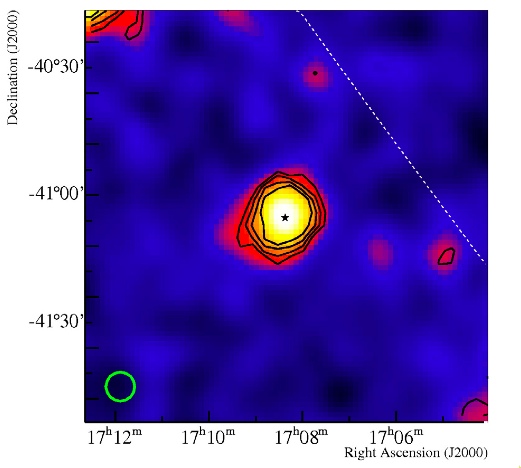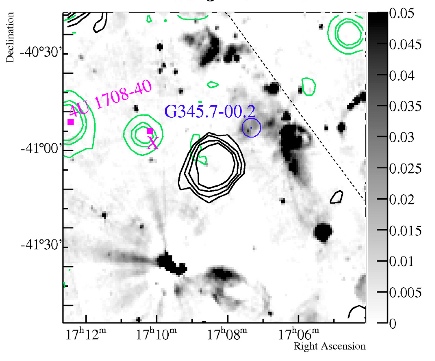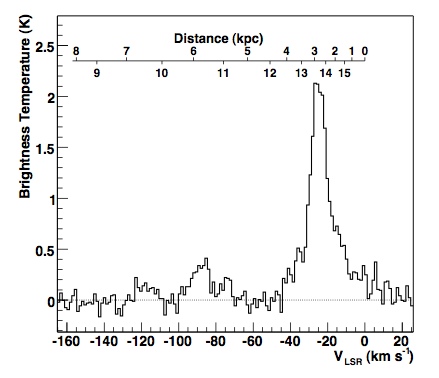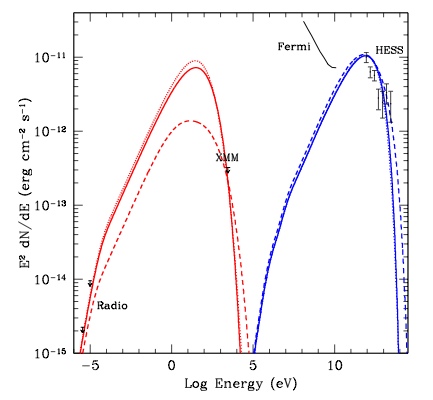More about HESS J1708-410
May 2010

Roughly half of the gamma-ray sources discovered by H.E.S.S. lack definitive counterparts at other wavelengths, and a few lack any plausible counterpart. HESS J1708-410 (Aharonian et al. 2008, top image) is one of those few VHE gamma-ray sources for which no plausible explanation has yet been put forward (Van Etten et al. 2009). HESS J1708-410 was discovered during the H.E.S.S. survey of the inner Galaxy (Aharonian et al. 2006); subsequent observations improved the statistical significance to 11 sigma. The compact source is only marginally extended on the scale of the H.E.S.S. angular resolution, consistent with a slightly elongated shape of approximately 0.08 degr. size. The spectrum of gamma rays extends from 0.5 TeV to beyond 30 TeV, with an energy flux of 8x10-12 ergs/cm2s. A multiwavelength view of the region (Fig. 1) does not reveal counterparts; the supernova remnant G345.7-00.2 is well separated from the gamma-ray source, as are radio hotspots and ROSAT X-ray sources.
The discussion of the nature of HESS J1708-410 was reopened by Van Etten et al. (2009), based on a new XMM-Newton 27 ks exposure of the region and on archival radio continuum and CO data, searching for either extended X-ray emission indicative of a population of high-energy electrons, or molecular clouds which might serve as a target for accelerated cosmic rays, and possibly host the accelerator. The new X-ray data show four X-ray point sources in the source region, and three additional sources at the periphery of the gamma-ray source. None of the X-ray sources indicates any sign of extended emission, as one would require for a plausible counterpart of the extended gamma-ray source. For diffuse X-ray flux from the region of HESS J1708-410, a flux limit of 3x10-13 erg/cm2s is given for the 2-4 keV range, well below the energy flux observed in gamma rays. The lack of diffuse X-ray emission is easily explained if HESS J1708-410 is an accelerator of cosmic ray nuclei, illuminating a nearby target. Analysis of CO data of Dame et al. (2001) in a 0.15 x 0.15 degr. pixel covering the gamma-ray sources indeed revealed a molecular complex at about 3 kpc distance (Fig. 2). To account for the observed gamma-ray flux assuming a modest target density of 10/cm3 in the cloud, a cosmic-ray energy input around 1050 ergs would be required, and could be provided by a typical supernova explosion. However, also the scenario of an electron accelerator cannot conclusively be ruled out. If the electron spectrum breaks off at high energy, either due to cooling losses and intrisic properties of the acceleration process, one can construct scenarios where the very high energy gamma ray spectrum is well described and the limit on the diffuse X-ray flux is obeyed (Fig. 3); in such scenarios, the synchrotron luminosity of the source is peaked well below the XMM range, and remains undetected.
Hence, the discussion about the nature of this gamma-ray source remains open; deeper radio observations might provide further clues.
Reference: "H.E.S.S. VHE gamma-ray sources without identified counterparts", H.E.S.S. collaboration, F. Aharonian et al., arXiv:0712.1173 and Astron. Astrophys. 477 (2008) 353-363


